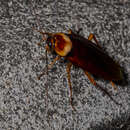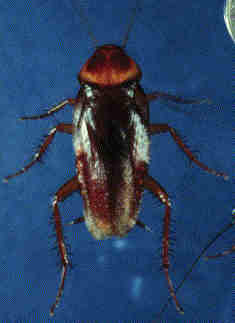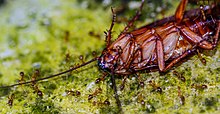en
names in breadcrumbs


As far as being a food source, cockroaches have a number of natural enemies. Spiders sometimes hunt them but are often too slow to catch the quick cockroach in a natural environment. Frogs, toads, and salamanders are more effective predators, and in Bermuda lizards are kept in the house to devour roaches. Finally, human beings from Australia to China to Japan have been known to eat roaches for nourishment or for medicinal value.
There is a picture of the American Cockroach at the following URL:

There is a 5-step process for the control of roaches.
(Bio-Serv 1998; Cochran 1980)
This species is considered a pest, and there are no efforts being made to conserve it.
US Federal List: no special status
CITES: no special status
State of Michigan List: no special status
This species is harmful to humans, and its impact on human health and economies is substantial. The greatest potential harm is an agent for disease transmission. American cockroaches can transmit a variety of bacterial diseases by feeding on contaminated material, and then contacting people's food. Cockroaches are also the fourth most common allergen. 50-60% of all atopic and asthmatic people show intense reactions to cockroach extract. Sensitivity to cockroach allergens may be as high as 79% in asthmatic children in severely infested homes. The species also has a psychological impact on humans, causing anxiety and stress due to embarrassment and physical invasion (Bio-Serv 1998; Cochran 1980).
Roaches themselves will eat anything, including one another. There is very little organic material that a cockroach won't eat. The list includes bark, leaves, paper, wool clothes, sugar, cheese, bread, oil, lemons, ink, soap, flesh, fish, leather, other roaches (dead or alive), or their own cast-off skins and egg-capsules. Some of these items, such as cellulose, can not be digested by normal means. However, like cows and other grazing animals, cockroaches have a symbiotic relationship with a bacteria that allows them to digest such substances. Although they feed on many kinds of food, they show a particular fondness for fermenting food.
(Helfer, 1972; Boraiko, 1981)
The American Cockroach, despite its name, is not native to North America but was most probably introduced via ships from Africa. It is currently worldwide in distribution.
(Smith & Whitman, 1992)
Biogeographic Regions: nearctic (Introduced ); palearctic (Introduced , Native ); oriental (Introduced ); ethiopian (Native ); neotropical (Introduced ); australian (Introduced )
Other Geographic Terms: cosmopolitan
P. americana is found in many different habitats. Although they generally live in moist areas, they can survive in dry areas if they have access to water. They prefer warm temperatures around 84 degrees Fahrenheit and do not tolerate cold. They die at temperatures below 15 degrees Fahrenheit. These criteria are often met in large commercial buildings such as restaurants, bakeries, grocery stores, food processing plants, hospitals, etc., where cockroaches may infest food-storage and food-preparation areas, basements, and steam tunnels. They are also found, although not as commonly, in residences. During the summer months, they can be found outdoors in yards and alleys. In the United States this is the most common species found in city sewer systems. They can enter structures by being brought in, coming up from the sewer system via drains, or occasional mass migration from other structures, dumps, etc., during warm weather.
(Cochran, 1980; Smith & Whitman, 1992)
Terrestrial Biomes: savanna or grassland ; forest ; rainforest ; scrub forest
Periplaneta americana adults are about 1 3/8 to 2 1/8 inches (34-53 mm) long. Their color is a reddish brown except for a submarginal pale brown to yellowish band around the edge of their pronotal shield (Pronotal shield - an expanded version of the top surface plate of the front segment of the thorax). Both sexes are fully winged. The wings of males extend beyond the tip of the abdomen, while females' do not. They are poor to moderately good fliers.
Early instars of P. americana nymphs are uniformly grayish brown dorsally, paler ventrally, and shiny. The cerci (cercus [pl. cerci]- One of a pair of dorsal appendages at the posterior end of the abdomen) are slender, and distinctly tapered from the base with length about 5 times the width. Later instars are reddish brown with lateral and posterior margins of the thorax and lateral areas (sides) of abdominal segments somewhat darker. The cerci are about the same as in the early instars. The widest segments are 2.5 times as wide as long. The antennae are uniformly brown.
The cockroach's walking pattern can be described as follows:
"The cyclic movement of a walking leg consists of two parts, the power stroke (also stance phase or support phase) and the return stroke (also swing phase or recovery phase). During the power stroke, the leg is on the ground where it can support and propel the body. In a forward-walking animal, this corresponds to a retraction movement of the leg. During the return stroke, the leg is lifted off the ground and swung to the starting position for the next power stroke."
(Cruse 1990; Cochran 1980; Smith & Whitman 1992; Bio-Serv 1998)
Other Physical Features: ectothermic ; bilateral symmetry
Female P. americana produce many different sex pheromones to attract a suitable mate. Examples of these attractive chemicals include periplanone-B, periplanone-A, germacradien-9-one, cresol, phenol, undecen, hexenal, cyclohexanedial, hexanoic acid, dodecalactone, pentanone, and octanone. Sperm transfer occurs through the use of a spermatophore, which is sometimes eaten by the female because of its protein-rich nature. (Spermatophore- Capsule or packet enclosing sperm, produced by males of several invertebrate groups and a few vertebrates). Once fertilization has occurred, a female forms oothecae, or egg sacs. Parthenogenesis or egg production without fertilization does occur, but eggs either fail to hatch, or produce only a few nymphs. The ootheca is a dark reddish to blackish brown; about 3/8" (8 mm) long, with length about1.5 times the width. The female deposits her ootheca within a few hours or up to 4 days after it is formed. It is dropped or glued with an oral secretion to a suitable surface, usually in a crack or crevice of high relative humidity near a food source.
On average, females produce 9-10 (range 6-14; maximum 90) oothecae, each containing 14-16 eggs. Developmental time (egg to adult) is greatly influenced by temperature, varying from 168-786+ days but averaging about 600 days under ordinary room conditions. During this time, they molt 10-13 times. Adult females live about 440 days (range 102-588; maximum 913) at ordinary room conditions(e.g. 70°F/20°C), but at 84°F/29°C, adult females live about 225 days (range 90-706), whereas adult males live about 200 days (range 90-362) at 84°F/29°C.
The development of P. americana is hemimetabolous, meaning there is no major metamophosis. The nymphs look very much like small adults.
Nymphs are given no parental care; hatchling roaches are left to fend for themselves. The nymph grows by molting and it goes through about 13 molts before it reaches the adult form. The next to last nymphal stage has wing pads, but only adult cockroaches have wings.
(Bell, 1981; Smith & Whitman, 1992)
There are approximately 4,600 species of cockroaches and they can be found all over the world, in every continent except Antarctica. Before you panic, though, only about 30 of these species can become pests. Most of them live in forests, whether under the ground, crawling across the forest floor or in trees, while others live in caves, fields, swamps and grasslands. One species of cockroach can even live in the desert, absorbing water vapor using its mouth structures in the absence of water.
According to the Guinness Book of World Records, the longest cockroach is theMegaloblatta longipennisfound in Central and South America, which can grow up to 3.8 inches long and have an 8-inch wingspan. The Central American giant cave cockroach can reach the same lengths but has a shorter wingspan, around 5 to 6 inches. The heaviest cockroach is the giant burrowing cockroach from Australia which can weigh over an ounce – as heavy as a CD. It is also the longest-lived cockroach, able to live for up to ten years.
And we mean any organic matter. Apart from eating any human food, cockroaches can eat dead insects, paper, cloth, soap, wood, glue, hair and poop. Yup, just about anything. This means cockroaches won’t ever run out of food, though they do prefer to eat sweets, starchy foods and meat. And guess what? Cockroaches can live for weeks without food! This has something to do with the fact that they are cold-blooded, like crocodiles and snakes, which means they can keep their metabolism rate low. Cockroaches cannot live long without water, though – just two weeks at most – and in fact, most dead cockroaches you see probably died of thirst (unless pesticide got them first).
The American cockroach (Periplaneta americana) is the largest species of common cockroach, and often considered a pest. In certain regions of the U.S. it is colloquially known as the waterbug,[1] though it is not a true waterbug since it is not aquatic. It is also known as the ship cockroach, kakerlac, and Bombay canary.[2] It is often misidentified as a palmetto bug.[3][4]
Despite their name, American cockroaches are native to Africa and the Middle East. They are believed to have been introduced to the Americas only from the 17th century AD onward as a result of human commercial patterns,[2] including the Atlantic slave trade.[5]
Despite the name, none of the Periplaneta species is native to the Americas; P. americana was introduced to what is now the United States from Africa as early as 1625.[2] They are now common in tropical climates because human activity has extended the insects' range of habitation, and are virtually cosmopolitan in distribution as a result of global commerce.[2]
Of all common cockroach species, the American cockroach has the largest body size; molts 6–14 times (mostly 13 times) before metamorphosis; and has the longest life cycle, up to about 700 days.[6]
It has an average length around 4 cm (1.6 in) and is about 7 mm (0.28 in) tall.[7] They are reddish brown and have a yellowish margin on the pronotum, the body region behind the head. Immature cockroaches resemble adults except they are wingless.
The cockroach is divided into three sections; the body is flattened and broadly oval, with a shield-like pronotum covering its head. A pronotum is a plate-like structure that covers all or part of the dorsal surface of the thorax of certain insects. They also have chewing mouth parts, long, segmented antennae, and leathery fore wings with delicate hind wings. The third section of the cockroach is the abdomen.[8]
The insect can travel quickly, often darting out of sight when a threat is perceived, and can fit into small cracks and under doors despite its fairly large size. It is considered one of the fastest running insects.[9]
In an experiment, a P. americana registered a record speed of 5.4 km/h (3.4 mph), about 50 body lengths per second, which would be comparable to a human running at 330 km/h (210 mph).[10][11]
It has a pair of large compound eyes, each having over 3500 individual lenses (ommatidia, hexagonal apertures which provide a kind of vision known as the mosaic vision with more sensitivity but less resolution, being common during night, hence called nocturnal vision.) It is a very active night insect that shuns light.[12]
American cockroach nymphs are capable of limb regeneration.[6]
The American cockroach shows a characteristic insect morphology with its body bearing divisions as head, trunk, and abdomen. The trunk, or thorax, is divisible into prothorax, mesothorax and metathorax. Each thoracic segment gives rise to a pair of walking appendages (known as cursorial legs). The organism bears two pairs of wings. The fore wings, known as tegmina, arise from mesothorax and are dark and opaque. The hind wings arise from the metathorax and are used in flight, though cockroaches rarely resort to flight. The abdomen is divisible into 10 segments, each of which is surrounded by chitinous exoskeleton plates called sclerites, including dorsal tergites, ventral sternites, and lateral pleurites.
American cockroaches have three developmental stages: egg, nymph, and adult.[13] Females produce an egg case (ootheca) which protrudes from the tip of the abdomen. On average, females produce 9–10 oothecae, although they can sometimes produce as many as 90. After about two days, the egg cases are placed on a surface in a safe location. Egg cases are about 0.9 cm (0.35 in) long, brown, and purse-shaped. Immature cockroaches emerge from egg cases in 6–8 weeks and require 6–12 months to mature. After hatching, the nymphs feed and undergo a series of 13 moultings (or ecdysis). Adult cockroaches can live up to an additional year, during which females produce an average of 150 young. The American cockroach reproductive cycle can last up to 600 days.[6]
When female American cockroaches are housed in groups, this close association promotes facultative parthenogenic reproduction.[6][14] The oothecae are produced asexually, without fertilization.[14] The process by which the eggs are produced is automixis;[15] during automixis, meiosis occurs, but instead of giving rise to haploid gametes as ordinarily happens, diploid gametes are produced (probably by terminal fusion of meiotic products) that can then develop into female cockroaches. Eggs produced by parthenogenesis have lower viability than eggs produced by sexual reproduction.[14]
The American cockroach genome is the second-largest insect genome on record, after Locusta migratoria. Around 60% of its genome is composed of repeat elements. Around 90% of the genome can be found in other members of Blattodea. The genome codes for a large number of chemoreceptor families, including 522 taste receptors and 154 olfactory receptors. The 522 taste receptors comprise the largest number found among insects for which genomes have been sequenced. About 329 of the taste receptors are involved in bitter taste perception.[6] These traits, along with enlarged groups of genes relating to detoxification, the immune system, and growth and reproduction, are believed to be part of the reasons behind the cockroach's ability to adapt to human living spaces.[16]
American cockroaches are omnivorous and opportunistic feeders that eat materials such as cheese, beer, tea, leather, bakery products, starch in book bindings, manuscripts, glue, hair, flakes of dried skin, dead animals, plant materials, soiled clothing, and glossy paper with starch sizing.[2][13] They are particularly fond of fermenting foods.[17] They have also been observed to feed upon dead or wounded cockroaches of their own or other species.
In the immature (nymph) stage, American cockroaches are wingless and incapable of flight. Adults have useful wings and can fly for short distances. If they start from a high place, such as a tree, they can glide for some distance. However, despite their ability to do so, American cockroaches aren't regular fliers. They can run very fast and, when frightened, these insects more commonly scatter on foot.
American cockroaches generally live in moist areas but can survive in dry areas if they have access to water. They prefer high temperatures around 29 °C (84 °F) and do not tolerate low temperatures. These cockroaches are common in basements, crawl spaces, cracks and crevices of porches, foundations, and walkways adjacent to buildings. In residential areas outside the tropics, these cockroaches live in basements and sewers and may move outdoors into yards during warm weather.
The odorous secretions produced by American cockroaches can alter the flavor of food. Also, if populations of cockroaches are high, a strong concentration of this odorous secretion can be present.[13] Cockroaches can pick up disease-causing bacteria,[18] such as Salmonella, on their legs and later deposit them on foods and cause food poisoning or infection if they walk on the food. House dust containing cockroach feces and body parts can trigger allergic reactions and asthma in certain individuals.[19]
At least 22 species of pathogenic human bacteria, viruses, fungi, and protozoans, as well as five species of helminthic worms, have been isolated from field-collected P. americana (L.)[20]

In cold climates, these cockroaches may move indoors, seeking warmer environments and food. Cockroaches may enter houses through sewer connections, under doors, or around plumbing, air ducts, or other openings in the foundation. Cockroach populations may be controlled through the use of insecticides. Covering any cracks or crevices through which cockroaches may enter and cleaning any spills or messes that have been made is beneficial, so cockroaches are not able to enter and are not attracted to the food source. Another way to prevent an infestation of cockroaches is to thoroughly check any material brought inside. Cockroaches and egg cases can be hidden inside or on furniture, in boxes, suitcases, grocery bags, etc.[13]
The American cockroach has been used as an ingredient in traditional Chinese medicine, with references to its usage in the Compendium of Materia Medica and Shennong Ben Cao Jing. In China, an ethanol extract of the American cockroach, kang fu xin ye, is used as a prescribed drug for wound healing and tissue repair.[6]
The American cockroach (Periplaneta americana) is the largest species of common cockroach, and often considered a pest. In certain regions of the U.S. it is colloquially known as the waterbug, though it is not a true waterbug since it is not aquatic. It is also known as the ship cockroach, kakerlac, and Bombay canary. It is often misidentified as a palmetto bug.
Despite their name, American cockroaches are native to Africa and the Middle East. They are believed to have been introduced to the Americas only from the 17th century AD onward as a result of human commercial patterns, including the Atlantic slave trade.